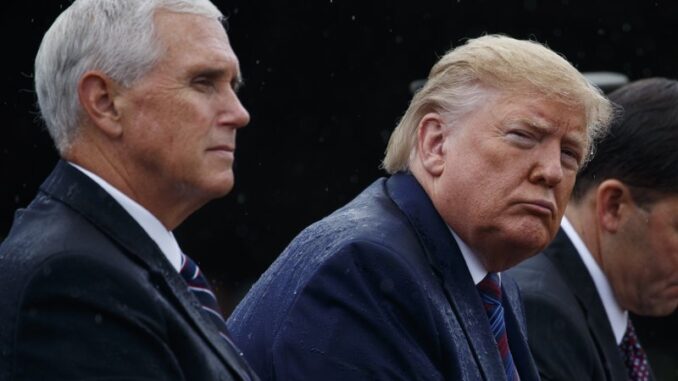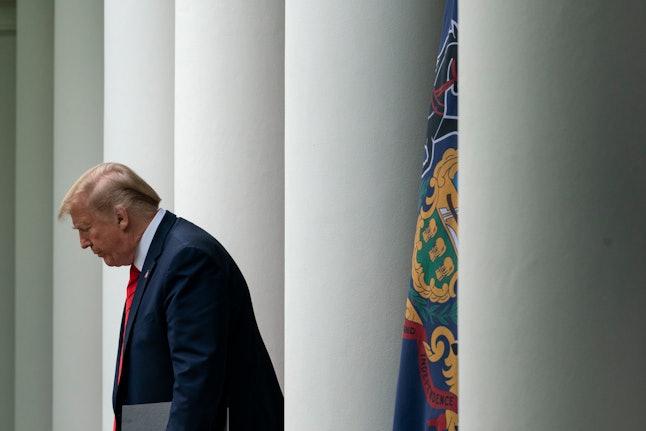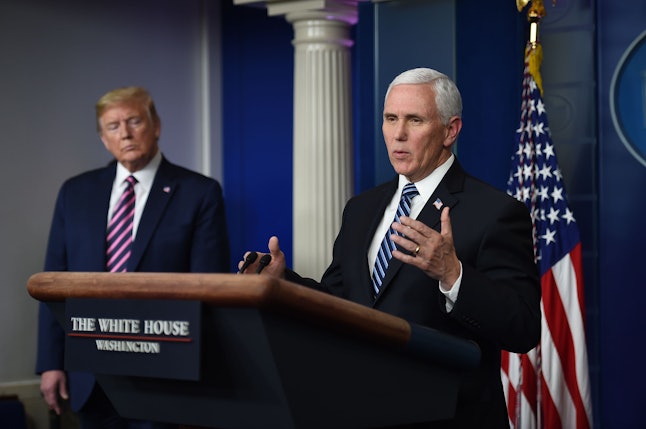
Unlike millions of Americans trying to protect themselves from coronavirus, President Trump refuses to wear a mask, at least when cameras are present. The president has turned the pandemic into a culture war battle, pitting red-state governors eager to reopen the economy against those — including top doctors in his administration — urging more caution. Eager to project optimism, Trump indeed seems to have decided that basic protective measures would undercut his message that Americans are “warriors” who should happily risk death for the sake of the economy. But as the virus tears its way through the White House, inching ever closer to the president, it begs the question: What happens if Trump gets coronavirus?
Katie Miller, a spokeswoman for Vice President Mike Pence and the wife of Trump’s immigration czar Stephen Miller, has tested positive for coronavirus, and the White House apparently spent the weekend desperately trying to trace who she’s been in contact with. At least 11 members of the Secret Service have reportedly also tested positive. Certain precautions are in place: The White House is conducting regular temperature checks of aides and testing both the president and the vice president daily. But still, it’s clear that Trump is not taking all available safety measures even as the virus infiltrates the White House, as he’s reportedly continued to hold in-person meetings in close quarters and has not required masks be worn at these gatherings.
So, what happens if the president contracts coronavirus? As an obese man in his 70s, Trump falls into the category of people who face an increased risk of severe health issues if he does fall ill, per the CDC.Coronavirus has a vast range of potential outcomes, ranging from mild flu symptoms to severe respiratory difficulties that require a ventilator and intubation. The latter case, where an affected individual would likely need to be medically incapacitated, presents the most complex situation when considering a sitting president. In the U.K., Prime Minister Boris Johnson was briefly hospitalized with coronavirus, which triggered extensive consternation because the country lacks a constitution and has no mandated chain of succession. Thankfully, the U.S. Constitution has rules laid down in several places for what happens when a president is incapacitated. In particular, the much-discussed 25th Amendment lays out the procedure through which power can be transferred to the vice president in the event that a president is still alive, but no longer able to function.

Introduced in 1965 in response to the assassination of President John F. Kennedy and ratified in 1967, the 25th Amendment spells out the rules for several different scenarios. Section 3 covers what happens when a president voluntarily “declares himself unable, transferring power to the VP as acting president,” explains Brian C. Kalt, a law professor at Michigan State University and the author of Unable: The Law, Politics, and Limits of Section 4 of the Twenty-Fifth Amendment. “Then the president declares himself able again and immediately retakes power.” Section 3 has been used before, once by President Ronald Reagan when he underwent colon surgery and twice by President George W. Bush when he had colonoscopies. In all three cases, the vice president served as acting president for a matter of hours.
If Trump needed emergency surgery for a health issue, and was aware of this need in advance, he could invoke Section 3 and transfer power to Pence until he’s recovered. Then, he could decide at any moment to resume his presidency.
More dramatic situations are covered by Section 4 of the 25th Amendment, which has never been used. This section covers a situation where the president is unable to serve, whether from mental or physical decline, but “can’t or won’t invoke Section 3 himself,” Kalt tells Mic. “In that case, the VP and a majority of the Cabinet (just the 15 Cabinet secretaries, NOT other “Cabinet-level” people like the chief of staff) declare the president is unable and the VP becomes acting president.”
However, unlike under Section 3, with Section 4 the president can’t automatically and unilaterally resume his duties when he feels better. Kalt explains that if a president removed by Section 4 declares that he’s once again able to serve, the vice president and Cabinet members have four days to challenge him. If they don’t challenge him, the president will resume his post four days after declaring he’s able.
But even if they do challenge him, it’s unlikely the other members of the administration could seriously stop a president from returning to duty, Kalt tells Mic. “The standard is ‘unable,’ and is not defined further,” Kalt says, so it’s a subjective definition. On top of that, “the process stacks the deck in the president’s favor if he contests [his removal], so the bar is really high.”

If the Cabinet doesn’t contest the president’s assertion, he automatically resumes his duties four days later. If they do mount a challenge, the matter moves to Congress. If two-thirds of the House and Senate agree with the Cabinet that the president is unable to serve, then the vice president continues serving as acting president. This doesn’t mean that the president is permanently booted from office for good — he can again ask for another vote on his ability to function as soon as he wants, and continue asking for votes as many times as he pleases. Meanwhile, the vice president would serve as both vice president and acting president, and would not be able to nominate a new vice president, Kalt says.
Of course, there’s always the chance that both Trump and Pence could contract the coronavirus. The third person in the line of presidential succession established in the Presidential Succession Act of 1947 is the speaker of the House of Representatives. Right now, that’s California Democrat Nancy Pelosi. The issue of succession if both the president and vice president are incapacitated is highly complex, however: Kalt explains that if vice president is also incapacitated, Section 3 or 4 cannot be used; when the amendment was drafted, Congress specifically noted this oversight but decided not to address it, assuming that such a situation would be exceedingly rare.
Furthermore, the 25th Amendment does not specify how anyone can assess the “inability” of a president to serve. Kalt describes a possible scenario where Pelosi could declare that neither Trump and Pence are able to function as president due to illness, and claim the presidency for herself, per the 1947 law. Trump and Pence could then take her to court, where the issue would eventually be resolved — but likely not before massive chaos descended on the federal government.
This partisan nightmare scenario seems like the stuff of West Wing fantasies. But assuming that a Pelosi presidency is an outcome Trump would like to avoid, he might want to consider wearing a mask.

You can check out the latest casting calls and Entertainment News by clicking: Click Here
Click the logo below to go to the Home Page of the Website
Click the logo below to follow ETInside on Twitter
Click the logo below to follow ETInside on Facebook
Click the logo below to follow ETInside on Instagram
Click the logo below to follow ETInside on Pinterest
Click the logo below to follow ETInside on Medium














